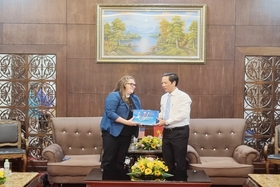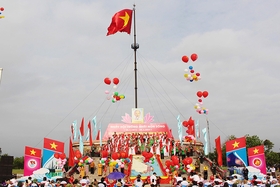{title}
{publish}
{head}
On July 21, 1954, the Geneva Accords established the Ben Hai River along the 17th parallel in Quang Tri Province as the provisional boundary dividing North and South Vietnam. The promised nationwide election for reunification was blocked by Ngo Dinh Diem’s regime and American support, leading to a 21-year struggle marked by hardship. Although the border region has changed, the memories of this historic period remain vivid.
Author Nguyen Tuan visited the 17th parallel many times during the war years and poignantly referred to the Hien Luong Bridge as the “ghost bridge” because “there were absolutely no pedestrians crossing it” (memoir “Ghost Bridge”).
He called the Ben Hai River the “river without two banks” (memoir “Border River”). The people on both sides of the Ben Hai River, after the My-Diem regime declared the border closed with the aim of permanently dividing the country, sorrowfully referred to the Ben Hai as a one-bank river because those on one side could not cross to the other.
Poems such as “Hien Luong, one stream with two currents/People on that side, but hearts on this side” and “Separated by a river, here longing for there/Together on one bridge, yet destiny apart” expressed the deep pain of the separation.

The historic Hien Luong Bridge was restored to its original form in 1954. Photo: N.T.H
Dividing line
The Ben Hai River, over 100 kilometers long, originates from the Dong Chan peak in the Truong Son range and flows eastward through vast forests to the Tien An railway bridge in Vinh Son Commune, runs through the plains of Vinh Linh and Gio Linh districts, and empties into the sea at Cua Tung. The river closely follows the 17th parallel, becoming the border river. In the past, it was called Minh Luong or Rao Thanh, and as it flowed through Vinh Son Commune, it was named the Ben Hai River, passing Hien Luong village, it was called the Hien Luong River, and when it reached Cua Tung, it became the Cua Tung River.
According to the 1954 Geneva Agreement, the 17th parallel was established as the temporary dividing line between North and South Vietnam for two years, leading to national elections to reunify the country. On August 25, 1954, when the last French forces withdrew from Vinh Linh across the Hien Luong Bridge, the Ben Hai River officially split the country into North and South.
Chairman of the Vinh Son Elderly Association, Nguyen Van Dung, took us to visit the relic of the Mieu Tho banyan tree dedicated to a Nguyen Dynasty queen consort in Nam Son Hamlet, on the north bank of the Ben Hai River. He explained that at this site, Company 1 of the Vinh Linh Border Guard, consisting of 100 officers and soldiers, was established on August 14, 1954.
This unit prepared the conditions to take over the Vinh Linh area from ten border guard posts along the Ben Hai River on August 25, 1954. In front of the Mieu Tho banyan tree was the Ben Ren (blacksmith’s ferry); opposite on the south bank, near Giang Phao village, was the Ben Loi, the shallowest part of the Ben Hai River in the plain, where one could wade across at low tide.

Ben Ren, the site of the May 20, 1967 event where US forces and the puppet regime opened fire, killing dozens of people from the south bank attempting to cross to the north bank of the Ben Hai River - Photo: N.T.H.
Before 1954, both banks of the Ben Hai River, from the Hien Luong Bridge up to the western mountains, belonged to Vinh Son Commune, Vinh Linh District, so families frequently visited each other. After the Geneva Agreement, the Ben Hai River became the temporary boundary dividing the two regions, splitting the commune, with one side belonging to Gio Linh District and the other to Vinh Linh District.
Many families were separated when My-Diem closed the border, with parents, spouses, and siblings suddenly becoming North and South citizens, unable to cross the river to see each other, enduring years of longing and sorrow.
People on the south bank, despite living under enemy control, remained loyal to their northern kin. To see their loved ones across the river, women would bring clothes and nets to the river to wash and dry, always looking for a glimpse of the other side: “Bringing clothes to the river to wash/Clothes wear out, but hearts remain pure/Bringing nets to the shore to dry/Nets dry, but eyes fill with tears.”
The political struggle to reunify the country continued until 1967, when the US bombed the Hien Luong Bridge and launched the “whiten the demilitarized zone” campaign, forcing people into a “white belt” on the south bank to prevent support from the North. The conflict intensified as the US aimed to “fill the Ben Hai River” and “advance north,” pushing Vinh Linh back to the Stone Age. Nguyen Van Dung recounted tearfully: "Knowing the enemy’s plan the day before, we organized a plan to fight and help people cross from the south to the north at Ben Ren, the shallowest part of the river. On May 19, 1967, we couldn’t cross due to continuous shelling and high tide. But at 3 a.m. on May 20, 1967, with the tide low, over 1,000 people crossed to the north. The enemy fired, killing dozens, turning the Ben Hai into a river of blood and tears."

Duong The Thu was once a border guard officer in Vinh Linh. Photo: M.D
The battle to reconnect the Hien Luong Bridge
While the Ben Hai River divided North and South Vietnam, the Hien Luong Bridge symbolized the desire for reunification. Despite the separation, the bridge remained a beacon of hope for 21 years. Just 100 meters wide, the river separated families for decades, causing immense sorrow.
One such story is that of Duong The Thu, born in 1937 in An Du Nam 1, Cua Tung town, Vinh Linh District. In 1954, Thu joined the border guard force, patrolling and securing the north bank of the Ben Hai River while his parents lived in the south, in Cua Viet, Gio Linh District.
"Our activities were secret, and we had to disguise ourselves when patrolling the south bank. If discovered, the enemy would shoot us on sight," Thu recalled.
Facing constant danger, Thu and his comrades navigated bombings and covertly crossed the river to relay information. In 1962, Thu married a woman from the north bank. Their brief meetings during his missions sustained their love until reunification. They exchanged letters filled with hope and longing, which helped them endure the hardships.
In 1973, after nearly two decades, Thu finally reunited with his family in the liberated Quang Tri. "I won’t dwell on the sacrifices because our generation was driven by the goal of reunification. Fighting and now living in peace is happiness compared to fallen comrades who never saw reunification," he said.
As the war escalated, Vinh Linh faced relentless bombardment. Elderly and children were evacuated north, while the able-bodied stayed to fight. Under constant threat, the people of Vinh Linh ingeniously built underground villages to survive and resist, earning the title "steel rampart."
At night, northern ferries quietly transported soldiers and supplies across the Ben Hai River to the southern front. Vinh Linh’s fishermen braved the sea to support the island of Con Co, demonstrating resilience and solidarity amidst the war.
Thanh Hai - Minh Duc - Tu Linh - Ngoc Mai

QTO - Quang Tri Province and Mukdahan Province, Thailand, on August 5 signed a cooperation plan for 2025-2030.

QTO - Vice Chairman Hoang Nam of the Quang Tri Provincial People’s Committee held a meeting with a delegation from PeaceTrees Vietnam, led by Executive...

QTO - A long-term development plan will bring about a new direction for Quang Tri Province in the future, Nguyen Dang Quang, Vice Secretary of the Quang...

QTO - The tales of war highlight the importance of peace. The narratives of revival in Quang Tri enhance the value of peace. The once war-torn and desolate...

QTO - After the war ended, the soldiers on both sides of the front line never thought that one day, they would set foot in each other’s country to tell the...

QTO - On May 23, as part of a dialogue program between the Organizing Committee of the Provincial Party Committee of Quang Tri (Vietnam) and the Organizing...

QTO - Director of Quang Tri’s Department of Information and Communications Nguyen Van Tuong discussed the role of digitalization in the province's efforts...

QTO - Vice Head of Quang Tri People’s Committee Office Le Huu Phuoc told the Quang Tri Newspaper about the province’s progress in pushing for administrative reform.

QTO - The Festival for Peace 2024 is an important event to promote Quang Tri as a peaceful destination for domestic and international friends.

QTO - On December 29, 2023, Deputy Prime Minister Tran Hong Ha signed Decision No. 1737 approving the provincial planning of Quang Tri for the period...

QTO - During the visit of Quang Tri's high-ranking delegation to Sekong Province, Laos, a meeting was held on March 18 with the objective of enhancing...

QTO - Mine Advisory Group (MAG), a Manchester-based non-governmental organization, celebrated its 25th year of operations in Vietnam in Dong Ha City on...